#bollywood blockbuster movies
Explore tagged Tumblr posts
Text



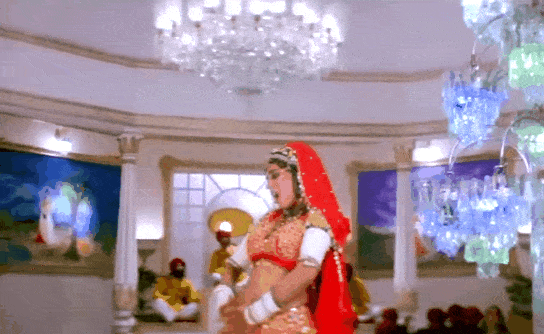

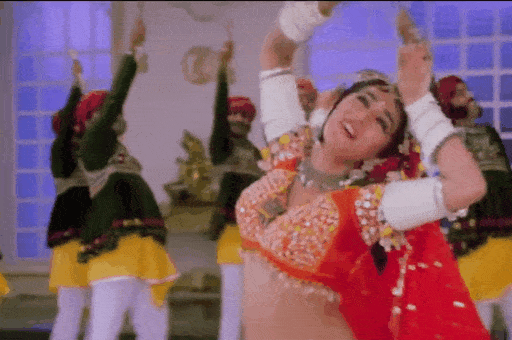
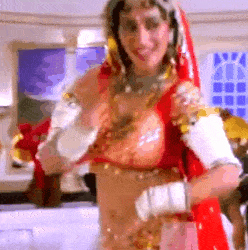
बेग़म बगैर बादशाह किस काम का
बादशाह बगैर बेग़म किस काम की...
#bollywood#evergreen#classic#hindi cinema#beautiful#madhuri dixit#sanjay#sanjaydutt#khalnayak#subhashghai#90s#90s movies#alka yagnik#jackie shroff#gulzar#rakhee#purani#blockbuster#hit#hindi music#hindi songs#madhuri
16 notes
·
View notes
Link
#bollywood#bollywood movies#movies#pathaan#jawan#tiger 3#box office#blockbuster#trend#trending#indian#india#film#cinema#love
2 notes
·
View notes
Text
Lights, Camera, Action! Border 2 has begun filming with Varun Dhawan leading the charge!
Lights, Camera, Action! Border 2 has begun filming with Varun Dhawan leading the charge. Get ready for a heroic saga! Releasing Jan 23, 2026.
Read the full article right here: https://www.theomenmedia.com/post/cameras-roll-on-border-2-varun-dhawan-joins-the-epic-military-drama

#Border 2#Varun Dhawan#Sunny Deol#Epic War Film#Bollywood#Action Movie#Patriotism#Border Sequel#Military Drama#Anurag Singh#Diljit Dosanjh#Ahan Shetty#Bollywood Blockbuster
0 notes
Text
Golmaal 5 upcoming film: The Much-Anticipated Bollywood Comedy of 2025
The Golmaal series is one of Bollywood’s most beloved and enduring comedy franchises, and fans have been eagerly awaiting its next installment. Directed by the powerhouse filmmaker Rohit Shetty, Golmaal 5 is set to hit the screens in 2025. The announcement of the movie has sparked excitement, speculation, and a renewed appreciation for the series’ unique blend of humor, action, and heartwarming…
#blockbusters#Bollywood comedy#film#Golmaal#Golmaal 1#Golmaal 2#Golmaal 3#Golmaal 4#Golmaal 5#movie#upcoming film
0 notes
Text
Fighter Bollywood Movie (2024) Review and Download
Director: Siddharth Anand
Writers: Siddharth AnandRamon ChibbAbbas Dalal
Stars: Hrithik RoshanDeepika PadukoneAnil Kapoor
Download Now
Fighter Movie Review: A High-Flying Action Spectacle with Familiar Turbulence
Siddharth Anand, best known for his work on blockbusters like War and Pathaan, takes to the skies with Fighter, a high-octane, big-budget aerial action thriller that aims to launch a new franchise. Starring Hrithik Roshan, Deepika Padukone, and Anil Kapoor, the film blends intense action, patriotic fervor, and a simmering romance, making it a quintessential Bollywood entertainer. While Fighter soars in its thrilling set pieces and charismatic performances, its reliance on clichés and underwhelming antagonists slightly grounds the overall experience.
Plot Overview
Set against the backdrop of the disputed region of Kashmir, Fighter revolves around a hand-picked team of Indian Air Force aviators tasked with neutralizing a looming threat. Commanding Officer Rakesh "Rocky" Jai Singh (Anil Kapoor) leads this elite squad, which includes the hotheaded yet skilled Shamsher “Patty” Pathania (Hrithik Roshan) and the determined helicopter pilot Minal “Minni” Rathore (Deepika Padukone).
While the team undergoes rigorous training, tensions escalate as terrorist Azhar Akhtar (Rishabh Sawhney) orchestrates attacks to destabilize the region. Politics, personal stakes, and romance intertwine as the aviators prepare for a showdown that puts their skills and lives to the ultimate test.
What Works
1. Star Power and Performances
Hrithik Roshan and Deepika Padukone are the film's undeniable anchors. Roshan embodies the reckless yet endearing "flyboy" archetype, delivering an emotionally charged performance. Padukone shines as the resilient and intelligent Minal, holding her own in action sequences and emotional beats. Their on-screen chemistry is electric, adding depth to their characters' relationship.
Anil Kapoor provides gravitas as the seasoned leader, blending authority with warmth. The supporting cast, including Karan Singh Grover and Akshay Oberoi, add layers to the team dynamic, even if their roles remain somewhat peripheral.
2. Thrilling Action Sequences
The aerial combat scenes are the film's heart, blending practical effects with CGI to deliver visually arresting dogfights. While some sequences stretch believability, the sheer scale and intensity of the action keep audiences riveted.
3. Entertainment Value
From energetic musical numbers to lighthearted camaraderie among the aviators, Fighter never loses its sense of fun. The film balances its romance, drama, and action well, ensuring there’s something for everyone.
What Doesn’t Work
1. Generic Villain and Plot
Rishabh Sawhney’s Azhar Akhtar looks like a menacing antagonist, but his character lacks depth. His motivations and plans are underdeveloped, reducing him to a generic foil rather than a compelling nemesis. The geopolitical backdrop, while intriguing, is glossed over, leaving the narrative feeling shallow.
2. Overindulgence in Bollywood Tropes
While Fighter embraces its escapist nature, it sometimes leans too heavily on slow-motion shots, melodramatic dialogues, and hyper-patriotic montages. These elements, while expected in a masala entertainer, occasionally detract from the film's pacing and impact.
3. Predictable Narrative
The film follows a well-trodden path, with familiar character arcs and predictable twists. While the execution is polished, the story lacks the originality needed to elevate it beyond standard action fare.
Final Thoughts
Fighter is an exhilarating spectacle that thrives on its star-studded cast, dynamic action, and Siddharth Anand’s signature style. While it doesn’t break new ground in terms of storytelling, its mix of high-flying thrills and charismatic performances ensures an entertaining ride. Fans of Hrithik Roshan, Deepika Padukone, and Bollywood’s larger-than-life action dramas will find plenty to enjoy, even if the film occasionally feels derivative.
Rating: 3.5/5 A visually stunning and entertaining action-drama that takes flight but struggles to soar above its formulaic roots.
FIGHTER Trailer | Hrithik Roshan, Deepika Padukone, Anil Kapoor | Siddharth Anand | 25th Jan 2024
Fighter movie review, Hrithik Roshan Fighter review, Siddharth Anand Fighter film, Fighter Bollywood action movie, Fighter film aerial combat, Deepika Padukone and Hrithik Roshan chemistry,
#Bollywood action franchise Fighter#Indian Air Force in Fighter movie#Fighter villain Azhar Akhtar#Fighter movie cast and performances#Siddharth Anand action movies#Bollywood blockbuster Fighter 2024#Fighter movie patriotic themes#Anil Kapoor Fighter performance#High-octane Bollywood action thrillers#movies#movie review#moviegifs
1 note
·
View note
Text
This Hit Film Had Comedy, Drama, And Romance, Released Same Year As Aamir Khan’s Blockbuster, Still Earned Rs 117 Crore, Budget Was Just Rs… | Movies News
Released in 2007, Welcome emerged as a landmark in Bollywood’s comedy genre. Directed by Anees Bazmee, the film featured a star-studded cast, including Akshay Kumar, Katrina Kaif, Nana Patekar, Anil Kapoor, and Mallika Sherawat in lead roles. Known for its laugh-out-loud moments and unforgettable dialogues, Welcome struck gold at the box office and continues to hold a special place in the hearts…

View On WordPress
#Akshay Kumar films#anees bazmee#Bollywood Blockbusters#Bollywood comedy#Box Office Hits#Feroz Khan#Katrina Kaif movies#Welcome Movie#Welcome to the Jungle
0 notes
Text
How are Movie streaming platforms changing how we watch movies?
In this digital age, the rise of movie streaming platforms has transformed how we watch movies. The new Movie streaming platforms have revolutionized the way movies are watched now. This means that the experience and the style of watching movies have changed.
#Latest movie releases#Box office collection#Best movie reviews#Movie streaming platforms#Top Hollywood movies#Box office predictions#Film industry news#Movie rankings 2024#Oscar winning movies#Best thriller movies#Upcoming blockbuster movies#Bollywood box office
0 notes
Text
Welcome to Lokesh Bhandari Review, your ultimate entertainment hub for insightful reviews! Dive into in-depth Web Series Reviews that spotlight the latest streaming hits, explore our curated OTT Movie Reviews for must-watch films, and enjoy expert Movie Reviews of recent blockbusters. Uncover hidden gems with our Under-Rated Reviews**, discover fresh content in Other OTTs, and relish nostalgic insights with our Retro Reviews of classic films. Stay informed and entertain
#bollywood#entertainment#movies#web series#hollywood#tollywood#retro review#Lokesh Bhandari Review#web series reviews#ott movies#movie review#blockbuster movies#film critique#bollywood review#ott content#movies to watch
0 notes
Text
The Latest Buzz in Bollywood: Top Stories You Can't Miss!
Bollywood, the heart of Indian cinema, constantly buzzes with news, gossip, and stories that keep fans and enthusiasts on the edge of their seats. From blockbuster releases to celebrity controversies, there’s always something happening in tinsel town. Here’s a roundup of the latest Bollywood news that’s making headlines.
1. Major Bollywood Release Takes the Box Office by Storm
The much-anticipated movie, Kalki 2898 AD , starring Amitabh Bachchan, Deepika Padukone, Prabhas has finally hit the theaters and is receiving an overwhelming response. The movie, directed by Nag Ashwin, has garnered ₹ 277.40 crore on its opening weekend, making it one of the biggest hits of the year. Critics have praised the film for its gripping storyline and stellar performances.
2. Celebrity Wedding Bells: Sonakshi Sinha and Zaheer Iqbal Ties the Knot
Bollywood's favorite couple, Sonakshi Sinha and Zaheer Iqbal, have finally tied the knot in a grand ceremony. The wedding, held at Mumbai on June 23 2024, was attended by the who's who of Bollywood. Exclusive photos from the event have taken social media by storm, with fans congratulating the newlyweds.
3. Controversy Alert: Rohit Shetty responds to Asim Riaz’s controversial statement “I have so much money you can’t even imagine” on Khatron Ke Khiladi 14
Bollywood star Rohit Shetty has found themselves embroiled in a legal controversy. Rohit Shetty addresses Asim Riaz's remarks and behaviour following the actor-model's dramatic exit from the reality show.
4. Upcoming Movies to Watch Out For
Bollywood has an exciting lineup of movies set to release in the coming months. From Phir Aayi Hasseen Dillruba Movie starring Taapsee Pannu & Vikrant Massey to Stree 2 Movie featuring Rajkummar Rao & Shraddha Kapoor, there’s something for everyone. Here’s a sneak peek into the most anticipated films.
5. Bollywood Fashion: Best Looks from the Red Carpet
The latest red-carpet event saw Bollywood stars bring their fashion A-game. From Explore the Newest Trends and Updates in Bollywood Style Icons for 2024 on Bollywood Hungama, here are the best looks that stole the show.
6. Exclusive Interview: Rajeev Khandelwal Talks About The Success of His Recent Show
In an exclusive interview, Rajeev Khandelwal opens up about their upcoming ott show, The actor discusses their role, the challenges faced during shooting, and what fans can expect from the show.
Bollywood Buzz: Latest Stories and Star-Studded Updates! Bollywood never fails to surprise and entertain its audience with its vibrant stories and star-studded events. Stay tuned for more updates and insider scoops on everything happening in Bollywood!
#Kalki 2898 AD box office collection#Kalki 2898 AD movie reviews#Amitabh Bachchan latest movie#Deepika Padukone new release#Prabhas blockbuster film#Sonakshi Sinha wedding#Zaheer Iqbal marriage#Bollywood celebrity weddings 2024#Rohit Shetty Asim Riaz controversy#Khatron Ke Khiladi 14 drama#Upcoming Bollywood movies 2024#Phir Aayi Hasseen Dillruba release date#Stree 2 cast and release#Bollywood red carpet fashion 2024#Bollywood style icons#Rajeev Khandelwal interview#Rajeev Khandelwal OTT show#Latest Bollywood news#Bollywood gossip 2024#Bollywood blockbuster releases
0 notes
Text
Download mirzapur season 3 👇👇👇👇👇

1 note
·
View note
Text
The Great Indian Box Office Riddle: Muscle Mayhem vs. Martyrs' Valor
In the ever-bewildering world of the Indian box office, a new enigma emerges. The war hero epic “Sam Bahadur” stands with quiet dignity, yet it’s the rip-roaring “Animal” that gallops ahead, leaving a shimmering trail of muscled bravado and shattered records. What’s behind this phenomenon? Is it just our hunger for escape, or something more profound at play?**The Seduction of Escapism:**Life’s…

View On WordPress
#2023#action thrillers#Animal movie#audience preferences#blockbuster films#Bollywood paradox#box office trends#cinematic contrasts#cinematic escapades#entertainment vs reality#escapism in film#film industry analysis#genre loyalty#hero worship#Indian box office dynamics#Indian cinema#Indian cultural commentary#marketing in Bollywood#movie choices#Ranbir Kapoor#real-life heroes#Sam Bahadur#societal reflections in cinema#war biopics
0 notes
Text
The Trailer Of Ajay Devgn , Aaman Devgan And Rasha Thadani's "Azaad" Is Out Now!
Experience the saga of bravery, loyalty, and freedom with Azaad! Ajay Devgn, Aaman Devgan, and Rasha Thadani star in this epic tale. Trailer out now!
Read the full article right here: https://www.theomenmedia.com/post/azaad-trailer-unveiled-ajay-aaman-devgn-s-epic-adventure-with-horse-loyalty-and-love

#Azaad Trailer#Bollywood Blockbuster#Azaad Movie#Historical Drama#Bollywood Debut#Ajay Devgn#Aaman Devgan#Rasha Thadani#Abhishek Kapoor#Action Adventure#Indian Cinema
0 notes
Text
Amitabh Bachchan's Untold Story: Rare Memorabilia Exposed!
Amitabh Bachchan’s Untold Story: In the glamorous realm of Bollywood, Amitabh Bachchan stands tall as the ‘Shahenshah.’ This legendary actor, known for his iconic roles in movies like ‘Zanjeer,’ ‘Deewar,’ ‘Ram Balram,’ ‘Sholay,’ and ‘Sharaabi,’ continues to captivate hearts even at 81! But did you ever think about owning a piece of his legacy? Well, now you can! 🎥✨ A Glimpse into Amitabh…
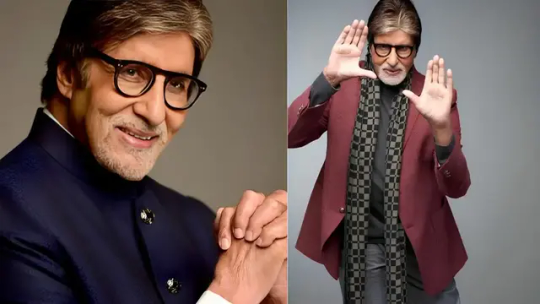
View On WordPress
#Amitabh Bachchan#Amitabh Bachchan Awards#Amitabh Bachchan Blockbusters#Amitabh Bachchan Career#Amitabh Bachchan Characters#Amitabh Bachchan Fans#Amitabh Bachchan Films#Amitabh Bachchan Interviews#Amitabh Bachchan Journey#Amitabh Bachchan Legacy#Amitabh Bachchan Life#Amitabh Bachchan Movies#Big B#Bollywood Great#Bollywood Icon#Bollywood Icon Amitabh#Bollywood Icon Amitabh Bachchan#Bollywood Iconography#Bollywood Legend#Bollywood Star#Bollywood Superstar#Indian Cinema#Indian Film Industry#Indian Film Legend#Legendary Actor
0 notes
Text
Rashmika Mandanna On A Blockbuster Spree With Animal, Pushpa 2: The Rule, And Sikandar! | People News
Rashmika Mandanna is undeniably on a remarkable journey through the film industry, especially following the success of ‘Animal.’ The actress is gearing up for a phenomenal lineup of eight upcoming films, further solidifying her position as a powerhouse in Indian cinema. With numerous accolades and a growing fan base, Rashmika has become one of the most beloved figures in the entertainment…
#Animal Movie Success#Bollywood Blockbusters 2024#Pushpa 2: The Rule#rashmika mandanna#Sikandar Film
0 notes
Text
HDHub4u:The Ultimate Site for Streaming and Popular Films
Looking for a reliable streaming site to watch new and popular films? HDHub4u is the ultimate solution! Discover a vast library of the latest movies and shows.
Introduction: In the present era of digitalization, a plethora of individuals across the globe prefer online streaming as their go-to source of entertainment. As there are several streaming platforms to choose from, the process of selecting an appropriate one can be quite arduous. However, if you seek a dependable streaming platform to view the latest and most popular films, HDHub4u is the…

View On WordPress
#Action movies#adventure movies#Animated movies#Blockbuster movies#Bollywood movies#Comedy movies#Drama movies#Family movies#Fantasy movies#film industry news#free movie streaming#HD movies#HDHub4u#HDHub4u review#high-quality streaming#Hollywood movies#latest movie trailers#movie ratings#Movie recommendations#movie reviews#movie suggestions#Movie website#new movie releases#online movie streaming#popular films#romantic movies#sci-fi movies#streaming movies#Thriller movies#top-rated movies
1 note
·
View note
Text
So I guess Film Twitter is apoplectic with rage over some people suggesting they have intermissions in long movies. Not over theaters adding one without the director's consent, but like, at the concept of them
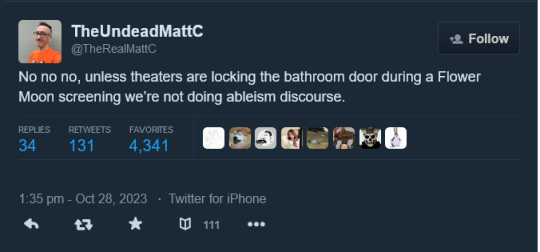
...by which I mean, getting mad at disabled people daring to have complaints. There's a lot of "HAHA are you so STUPID you can't go beforehand? You can't HOLD it for three hours?" and implying you don't deserve to experience art if you can't

And, of course, because Film Twitter is a bunch of insular discourse-addled dipshits, they're tying this...to Marvel. Yes, people are only saying they have health conditions that make sitting still for a three hour movie is because...they're Marvel fans mad at Scorsese, or something?
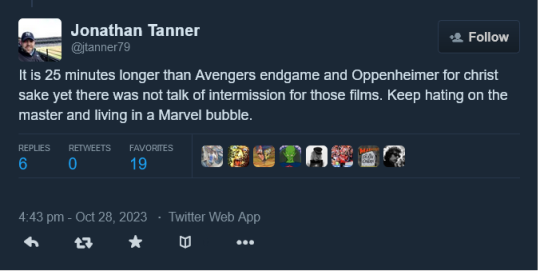
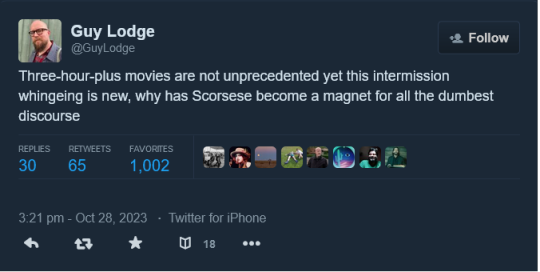
Why is this complaint new? Well, bc runtimes are ballooning to the levels of the old epic filmmaking days of the 50s-70s. And those movies...had intermissions. Multi-act plays have intermissions. Bollywood films have intermissions. Intermissions were literally just abandoned so studios could cram in more screenings, not out of an artistic ideal. But anyone saying "this would make it easy for me to access this film I want to see" needs to be viciously shouted down and called a moronic, lazy child hating on Scorsese bc of "discourse"


I've seen that meme multiple times and Jesus, look at the bizarre disdain for your fellow human beings embedded in it. You dare still bodily exist during a Martin Scorsese movie? You have a disability I don't? Well, I have no problem just peeing beforehand and not buying popcorn or a soda (you should really just sit their quietly until it's done, when you can pull out your phone to log it on Letterboxd), so what's your problem?
Calling people who are into non-blockbuster films "film bros" is mostly untrue, but man, the hardcore Film Twitter types unambiguously check every box. They're certainly dismissive of anyone outside their little box; extremely insulting, in fact, of how anyone who disagrees with them even slightly must be a Marvel-addled hysterical artless moron. Because nothing says "artistic appreciation" like preemptively calling analysis of a movie's choices "discourse" ("Ugh, I can't believe the DISCOURSE about how a movie portraying a morbidly obese man portrays obese people" - what should they talk about, then, if the movie's subject is instantly off the table?) They think the idea that someone out there may have a disability that prevents them from sitting in one place for three and a half hours is a laughable thing made up by the internet; or when people pointed out that a movie only getting one or two screenings a city may be inaccessible to working people, and these bloggers and podcast hosts dunked on the idea that working class people may like art as a hilarious, made-up thing.
I don't know, maaaaaaybe classing the life experiences and complaints of anyone who isn't you as "discourse" and presuming it's made-up kvetching about nothing as a matter of course is bad, cruel nonsense, actually?
784 notes
·
View notes